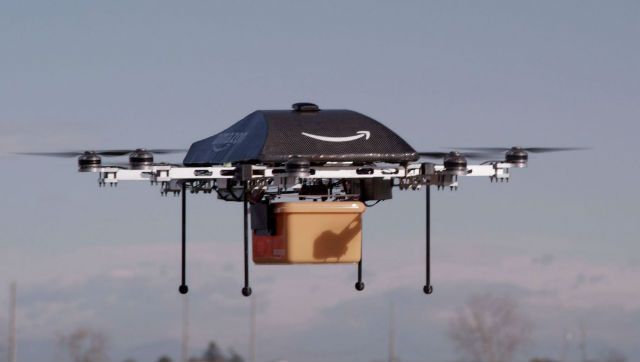Amazon is looking to recruit British employees to join its Prime Air unmanned air vehicle delivery service project, which until now was largely centred out of its Seattle headquarters.
The company’s job site lists vacancies for a flight operations engineer, project manager, software development engineer and senior research scientist, all to work for the Prime Air initiative and to be based at Amazon’s Cambridge, UK facility.
“We’re working on the future,” the job vacancies state. “If you are seeking an environment where you can drive innovation, if you want to apply state-of-the-art technologies to solve extreme-scale real world problems, if you want the satisfaction of providing visible benefit to end-users in an iterative fast-paced environment, this is your opportunity.”
Amazon first detailed its intention to deliver parcels by UAV in December 2013, when chief executive Jeff Bezos announced that the firm would enhance its Prime delivery service with the use of rotary-wing UAVs.
The company showcased a video of a vertical take-off and landing UAV that would deliver parcels to customers’ doorsteps, much to the interest – and concern – of many worldwide.

Rex Features
In light of airspace restriction concerns, Amazon sent a letter to the US Federal Aviation Administration in July 2014 calling for an exemption on current restrictions, so that Amazon Prime Air could become a reality – a service it now appears to be spreading to the UK.
All four vacancies are looking for “technical aptitude” and familiarity with complex systems, while there is also a desire for the flight operations engineer to have experience in the certification of UAVs, as the employee will be required to flight test the future system.
“You can expect to collaborate on test plans, plan the test evolution and execute the flights while working closely with our flight engineering and flight test teams in Seattle,” Amazon says. “We're looking for aerospace, systems or other engineers with extensive UAS flight experience. Success will require attention to detail, a safety-oriented attitude, flexibility and creative problem solving.”
Amazon is not alone in its exploration of UAVs for this application. In August Google introduced its UAV parcel delivery offering in the form of a fixed-wing prototype, under a development programme dubbed Project Wing.
The company tested out a prototype in Australia through its Google X research division, although the firm admitted at the time it was “years from a product”.
In September, German postal service DHL Parcel announced it was to embark on a more tangible UAV delivery endeavour, as it was about to begin a test phase delivering supplies using its Parcelcopter platform.
A restricted flight area for the UAV was established by the German ministry of transport and digital infrastructure, in co-ordination with Deutsche Flugsicherung – the company in charge of air traffic control in the country.
The flightpath covers some 6.5nm (12km) of the North Sea from the city of Norden to the island of Juist, and marks the first operation of a UAV in European airspace beyond line of sight.
The company – owned by Deutsche Post – first flew the vertical take-off and landing (VTOL) Parcelcopter in December 2013, when it travelled across the river Rhine at Bonn.
Source: FlightGlobal.com






















